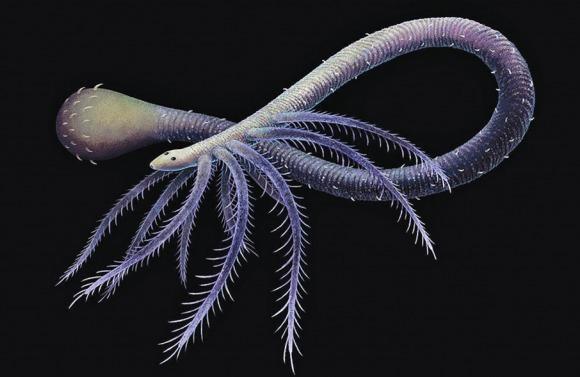 This image taken from the website of the University of Exeter shows an artist's impression of the tube-dwelling facivermis, which lived more than 500 million years ago.
This image taken from the website of the University of Exeter shows an artist's impression of the tube-dwelling facivermis, which lived more than 500 million years ago.
A 518 million-year-old fossil of a wormlike creature found in China has provided the earliest known evidence of an organism evolving to lose body parts, a process known as "secondary loss" in biology.
The fossil of the marine animal, known as facivermis, was discovered in the Maotianshan Shales, a paleontological hot spot in Southwest China's Yunnan province.
Facivermis had a long, tapered body, with five pairs of spindly legs near its narrow head and a bulbous tail that sat inside a tube anchored to the seabed.
A new study by researchers from the University of Exeter in the United Kingdom and Yunnan University in China suggests that facivermis was itself a lobopodian, and that it had evolved to lose its rear legs after adopting a sedentary lifestyle
Previous studies of facivermis fossils hypothesized that the animal was the "missing link" between cycloneuralians, a family of legless worms, and lobopodians, caterpillarlike sea creatures with legs all along their bodies from which insects, shrimps and spiders are descended.
ALSO READ: Scientists find possible evidence of DNA preserved in dinosaur fossils
However, a new study by researchers from the University of Exeter in the United Kingdom and Yunnan University in China suggests that facivermis was itself a lobopodian, and that it had evolved to lose its rear legs after adopting a sedentary lifestyle.
"A key piece of evidence was a fossil in which the lower portion of a facivermis was surrounded by a tube," said Richard Howard, a paleobiologist at Exeter and lead author on the paper published in the journal Current Biology.
"We don't know the nature of the tube itself, but it shows the lower portion of the worm was anchored inside by a swollen rear end," he added. "Living like this, its lower limbs would not have been useful, and over time the species ceased to have them."
Howard believes this might be the earliest evidence of "secondary loss", where an organism evolves to relinquish parts of its anatomy. Many examples of this loss of traits can be found in animals today. For example, the ancestors of snakes once had legs, and some species of cave-dwelling fish and amphibians evolved from sighted descendants to have nonfunctional, or even absent, eyes.
READ MORE: Fossil skull may hold answers to evolution of human species
"We generally view organisms evolving from simple to more complex body plans, but occasionally we see the opposite occurring," said Ma Xiaoya, a paleobiologist from Yunnan University who contributed to the study. "What excited us in this study is that even at this early stage of animal evolution, secondary-loss modifications-and in this case, reverting 'back' to lose some of its legs-had already occurred."


